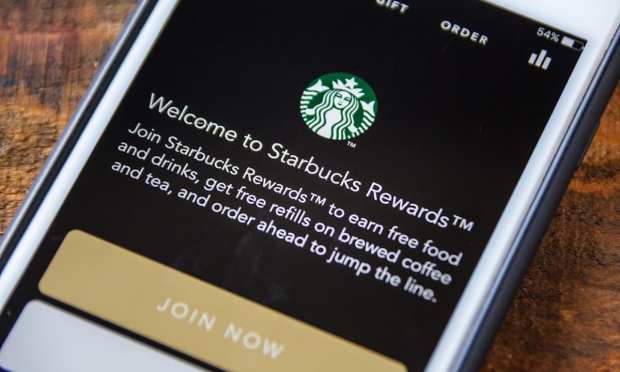Starbucks Q4 Earnings Show Record-High Loyalty Program Participation

In September, Starbucks announced changes to its loyalty program that expanded rewards to customers paying without a Starbucks card, eliminating a key friction point in growing its membership base. The changes are working. As announced on Tuesday (Jan. 26), loyalty app usage was up 15 percent year over year, according to the chain’s Q1 fiscal 2021 results, and rewards customers contributed 50 percent of U.S. company-operated sales. Additionally, mobile orders comprised 25 percent of all national company-operated transactions in the first quarter, an eight-point increase from the pre-pandemic share of 17 percent.
“This strong member growth that we’re seeing is not only surpassing our pre-COVID highs, but it’s pushing well beyond,” said CEO Kevin Johnson on a call with analysts. “And you saw the numbers: 22 million active members, that’s up 15 percent year over year. And it’s helping us really fuel the all-time highs that we’re seeing in Starbucks rewards as they convert.”
The program has helped offset some of the losses the chain has seen this quarter, due in large part to the pandemic. Comparable store sales were down 5 percent internationally, as were consolidated net revenues, which totaled $6.7 billion.
While traffic was down this quarter, with the company seeing a 19 percent decrease in comparable transactions, the average ticket was up 17 percent, as the pandemic drove behavioral changes such as increased group orders, more premium beverage choices, and a record-high amount of food attachments to these beverage-centric orders. Johnson attributes this in part to consumers’ desire for “safe, familiar, convenient experiences” in this uncertain time. This ticket spike could be short-lived, but it may have a lasting effect on customer behavior.
“I think as we start reopening seating in our stores, as vaccinations continue to propagate around the world, we’re going to see that normalize,” said Johnson. “But I do think there’s going to be a long-term positive impact on tickets. I do think, through this period, customers have gotten very used to more premium beverages [and a] higher degree of food-attach.”
The Push For Drive-Thru
Unsurprisingly, given consumers’ safety concerns during the pandemic, drive-thru stores performed well in Q1. As Johnson explains, “They drove over half of net sales in Q1, increasing more than 10 percent from pre-pandemic levels. These results give us confidence that our targeted initiatives to unlock capacity and enhance the customer experience at our drive-thru locations are boosting our business recovery, while strengthening our foundation for future growth.”
Chief Operating Officer Rosalind Brewer, whom it was just announced will be leaving the company in March to be the CEO of Walgreens, identified key approaches to optimizing drive-thrus: Optimize workflow as it currently operates by trying out new drive-thru solutions (such as handheld POS), improving order handoff technology and creating drive-thru-only locations with no seating. “When we look at our most productive model, it is the drive-thru,” Brewer said. “So in our go-forward position, you’ll see an increased number of drive-thrus … We’ve got considerable work in this area to unlock the full potential.”
Investing In Employee Satisfaction While Improving Work Flow
As the unpredictable coronavirus keeps employees’ hours in flux, Starbucks continues to prioritize employee satisfaction. As Johnson explains, “There’s a direct correlation between investment in partners, customer connection scores and traffic increase, and I think that’s the first thing to note … that’s why you saw it make a fairly significant increase in wage and benefits here in the U.S. as we went into the fiscal year.”
To offset some of the cost of investing in its employees, Starbucks is optimizing its tools for store efficiency. In addition to testing out operations solutions in the Tryer Center lab, the company is leveraging artificial intelligence (AI) and Internet of Things (IoT) technology to identify areas where the process can be improved. Deep Brew, the company’s AI tool, analyzes equipment and workflow to look for places where productivity can be boosted. IoT sensors identify potential equipment failures before they occur, saving the time it would take an employee to solve the problem. The goal is to free up employees to dedicate as much of their work time as possible to making beverages and connecting with customers.
Growth In China
Starbucks saw significant growth in China, its fastest-growing market, with a 5 percent increase in comparable-store sales (from 27 percent to 32 percent), with a 9 percent increase in average ticket size. “What is most remarkable about our recovery in China is the rapid re-acceleration of new store development, which is our No. 1 driver of growth in that market,” said Johnson.
Over the course of the quarter, the coffee chain opened close to 160 additional stores in the country, yielding a 13 percent increase in net new stores in the year. Locations opened in 15 new Chinese cities. Active rewards program participants grew rapidly. The program’s base of 15.4 million participants marked a 51 percent increase from the previous year and a 14 percent increase from the previous quarter. Together, the 15,340 U.S. stores and China’s 4,863 stores made up 61 percent of the company’s global portfolio by the end of the quarter.
